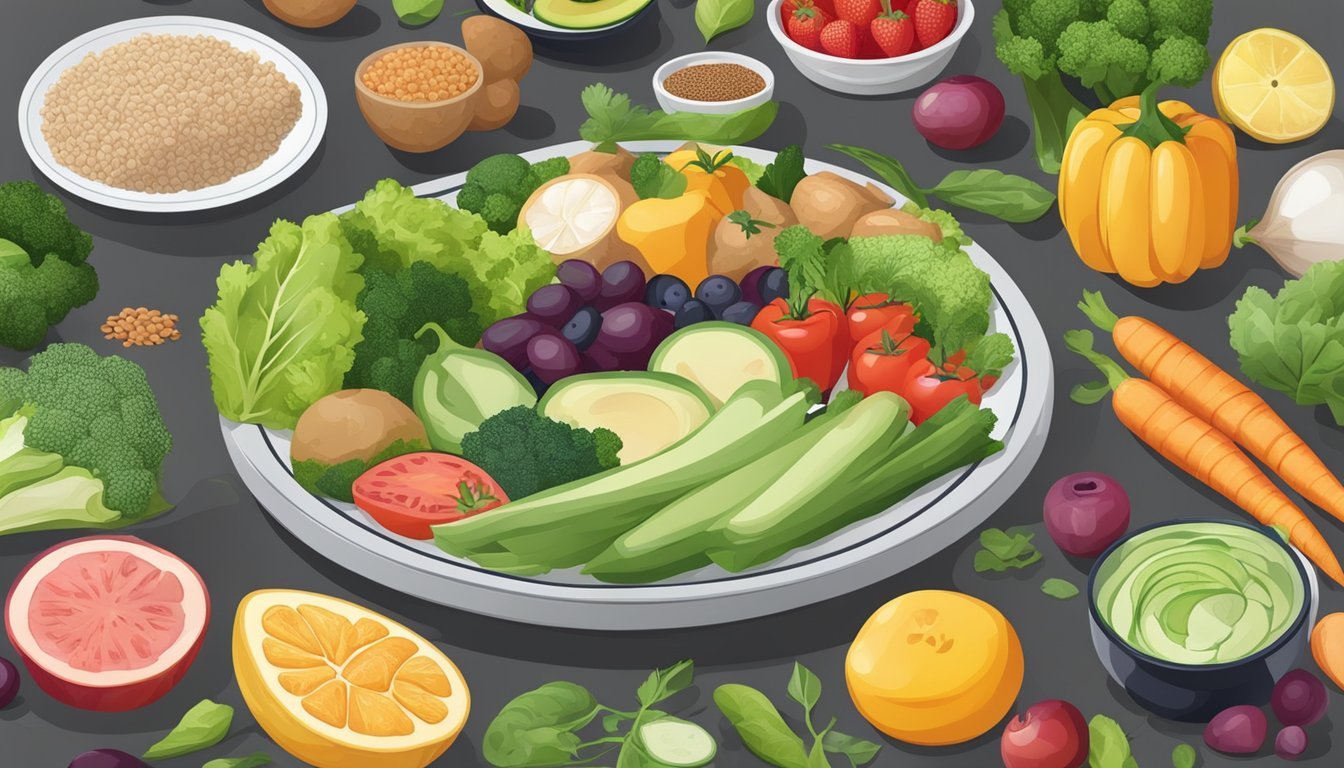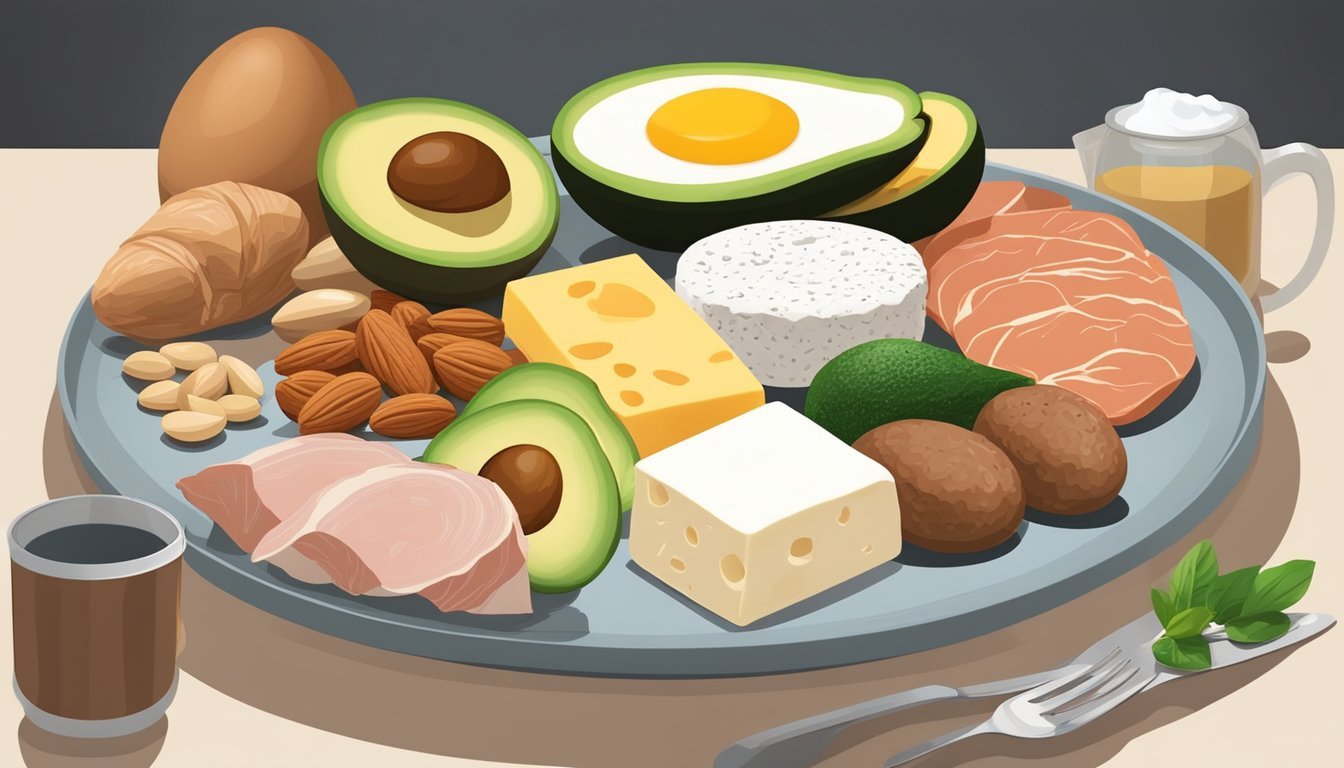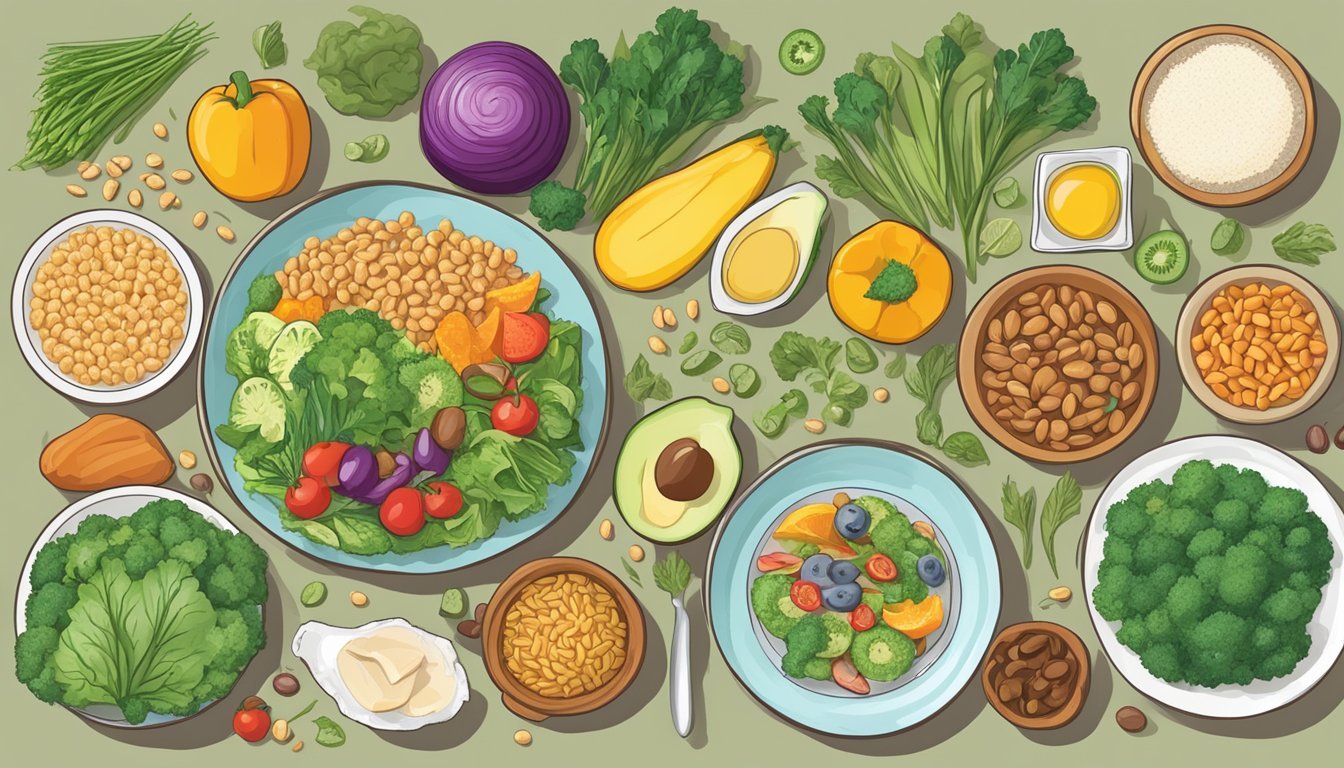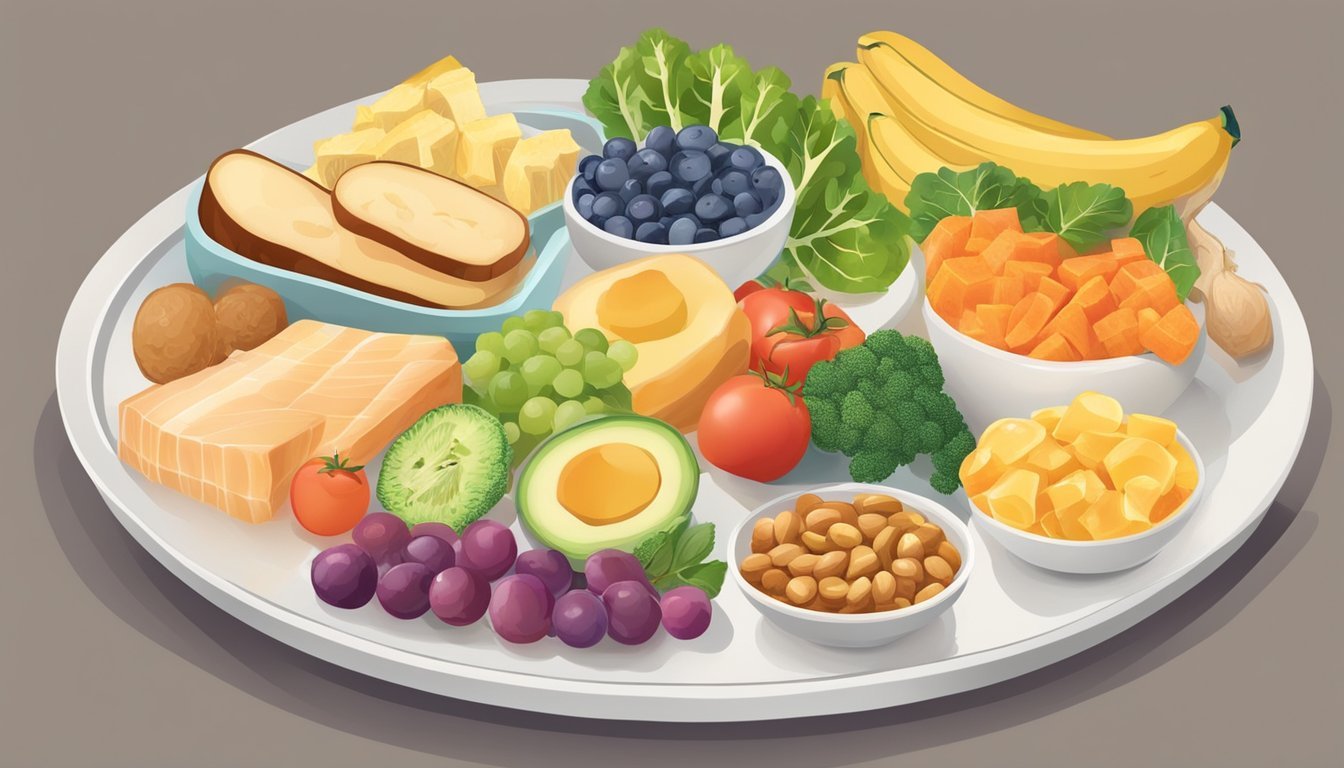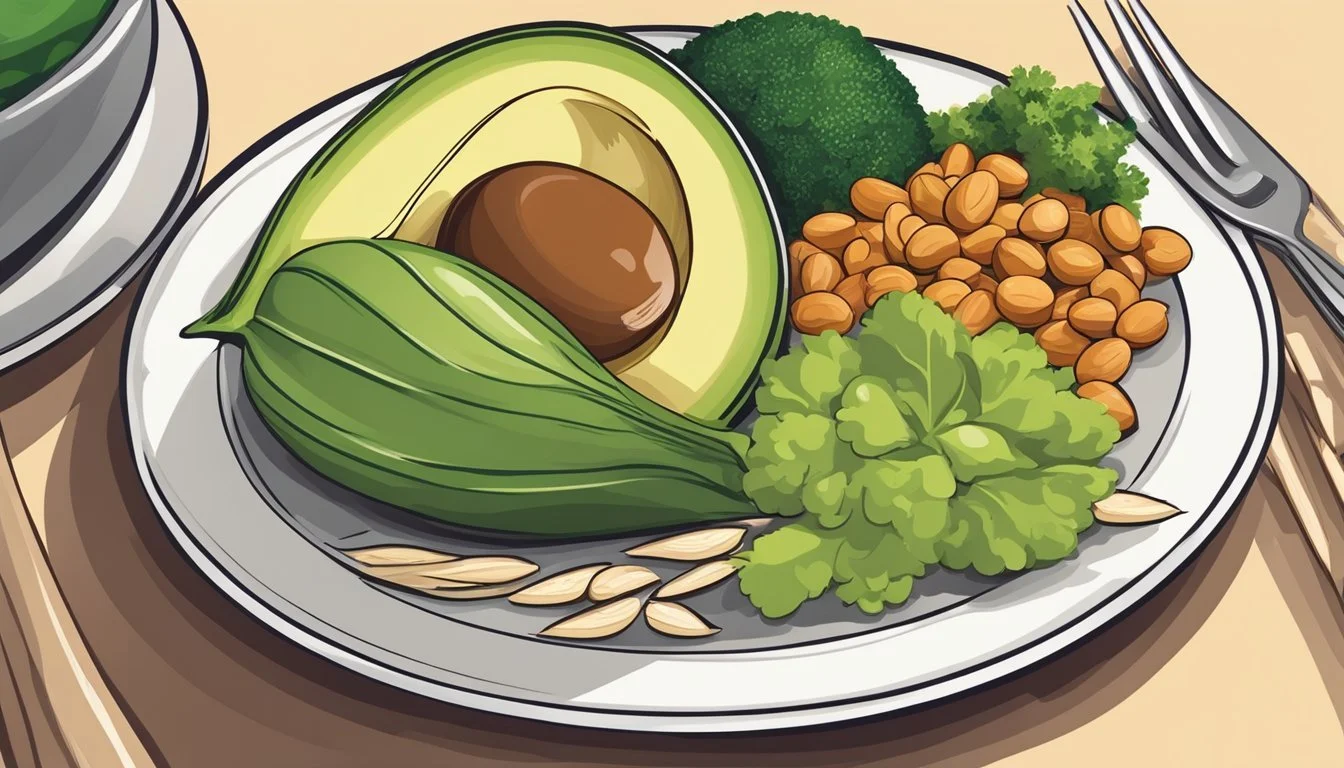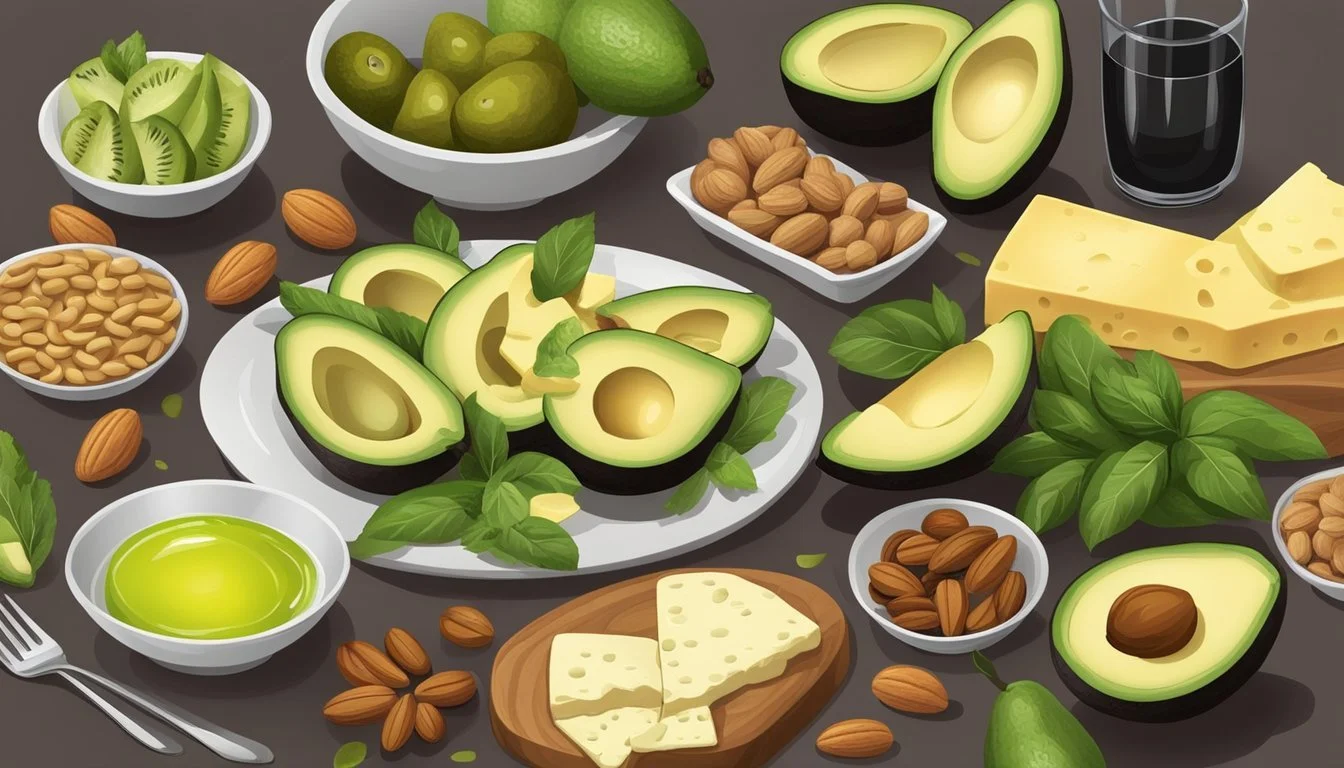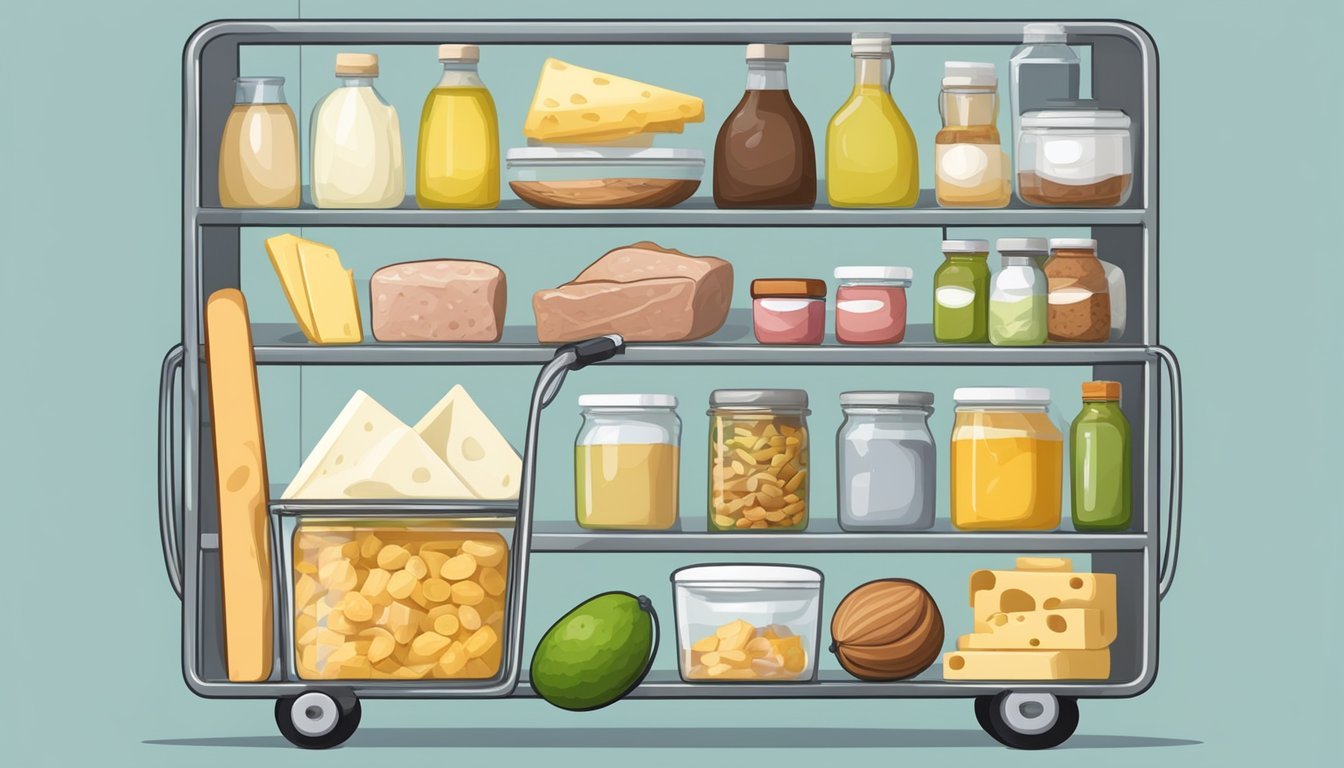High-Fat Diet: Balancing Your Plate with Nutritional Knowledge
A high-fat diet often conjures images of unhealthy and processed foods, yet fat is an essential component of a balanced diet. Fats play a crucial role in nutrition, providing energy, supporting cell growth, protecting organs, and keeping the body warm. They also aid in the absorption of important vitamins and help in the production of essential hormones. The challenge lies in choosing the right types of fats and incorporating them into one's diet in a way that supports overall health.
The concept of a balanced plate, popularized by dietary guides such as MyPlate, emphasizes the importance of portion control and nutrient diversity. When adapting MyPlate guidelines to include a higher proportion of fats, it's essential to select monounsaturated and omega-3 fatty acids which have been associated with numerous health benefits. These fats can be found in foods like avocados, nuts (What wine goes well with nuts?), seeds, olive oil, and fatty fish.
Healthy eating is not only about selecting the right foods but also about creating meals that are both satisfying and nutritionally complete. A balanced plate that includes healthy fats can enhance satiety, provide sustained energy, and contribute to a well-rounded diet. When portioning a plate, it typically involves filling half with non-starchy vegetables, a quarter with lean protein, and the remaining quarter with whole grains or starches. Adding healthy fats in moderate amounts to this configuration can create a nutrient-dense meal that supports a healthy lifestyle.
Understanding Fats
In the context of a high-fat diet, it is crucial to distinguish between the varying types of fats and understand their effects on the body. This section explores the fundamental categories of fats and differentiates between healthy and unhealthy fats.
Types of Fats
Fats can be categorized into two main groups based on their chemical structure: saturated and unsaturated fats. Saturated fats typically come from animal sources and are solid at room temperature; examples include butter and coconut oil. In contrast, unsaturated fats are usually liquid at room temperature and can be found in olive oil and avocado. Unsaturated fats are further divided into monounsaturated and polyunsaturated fats. Additionally, trans fats are a third type, often produced industrially by hydrogenating vegetable oils to become solid, found in many processed foods.
Type of Fat Sources State at Room Temperature Saturated Fats Butter, Coconut Oil, Animal Fat Solid Unsaturated Fats Olive Oil, Avocado, Nuts, Fish Liquid Trans Fats Processed Foods, Margarine Solid or Semi-Solid
Healthy Fats vs. Unhealthy Fats
When balancing a high-fat diet, discerning between healthy fats and unhealthy ones is critical for maintaining good health. Healthy fats, such as monounsaturated and polyunsaturated fats, support heart health and can be found in foods like olives, (What wine goes well with olives?) avocados, and fatty fish. These fats contribute positively to cholesterol levels by increasing high-density lipoprotein (HDL) while reducing low-density lipoprotein (LDL).
On the other hand, unhealthy fats, primarily saturated fats and trans fats, should be consumed in moderation. While some saturated fat can be part of a healthy diet, excessive intake is linked to higher levels of LDL cholesterol, which can increase the risk of heart disease. Trans fats, although now less common due to regulations, are particularly harmful since they both raise LDL cholesterol and lower HDL cholesterol.
It's essential for individuals to prioritize healthy fats such as:
Monounsaturated fats: Olive oil, nuts, and avocados.
Polyunsaturated fats: Found in certain types of fish and seeds.
Avoidance or limited consumption of products high in unhealthy fats like processed foods containing trans fats and high quantities of saturated fats is recommended. Additionally, when consuming fats, one should consider the total caloric intake as all fats are calorie-dense.
Proteins in a High-Fat Diet
Proteins play a crucial role in a high-fat diet by contributing to satiety and maintaining lean body mass. In this diet, it's essential to source high-quality protein that complements the high fat intake without skewing the macronutrient balance.
Animal-Based Proteins
Meat: Lean choices such as chicken and turkey provide muscle-building protein with relatively lower fat content. They should be cooked using healthy methods like grilling or baking to keep additional fats to a minimum.
Fish: Fatty fish like salmon offer omega-3 fatty acids alongside a healthy dose of protein. Salmon can be an excellent component of a high-fat diet, contributing both protein and beneficial fats.
Eggs: A versatile protein source, eggs are packed with nutrients. They contain healthy fats, particularly in the yolks, and can be included in various meals.
Dairy: Options such as cheese and yogurt contribute calcium and protein. Opting for full-fat versions fits well within a high-fat diet, with Greek yogurt being a particularly dense protein source.
Plant-Based Proteins
Legumes and Beans: These include lentils, black beans, and chickpeas. They are high in protein and fiber which can support a high-fat diet by providing essential nutrients and aiding digestion.
Tofu: Made from soybeans, tofu is a plant-based protein that is adaptable to many dishes and suitable for those on a high-fat diet looking for a meat alternative.
Nuts and Seeds: Almonds, chia seeds, and flaxseeds are examples of protein-rich nuts and seeds that complement a high-fat diet well, offering a balance of protein, fats, and fiber.
Protein Foods Summary:
Source Protein Type Notes Meat (Chicken) Animal Lean protein, cook without added fats Salmon Animal Offers omega-3 fats along with protein Eggs Animal Nutrient-rich, containing both protein and healthy fats Cheese Animal High in protein and fat, choose full-fat varieties Lentils Plant High in protein and fiber, beneficial for digestion Tofu Plant A versatile, plant-based protein Almonds Plant Provide protein, healthy fats, and fiber
Each of these protein sources can be integrated into a high-fat diet. Portion sizes and preparation methods should be considered to maintain the high-fat, moderate protein, and low carbohydrate balance.
Smart Carbohydrates
When considering carbohydrates in a high-fat diet, one must focus on quality and digestibility. Choosing the right types of carbohydrates is essential for maintaining energy balance and overall health.
Whole Grains and Fiber
Whole grains are preferred over refined grains because they retain their nutritional value. They provide essential fiber which aids in digestion and helps maintain a healthy gut microbiota. For a diet rich in high-quality carbohydrates, individuals should incorporate:
Oats: A great source of soluble fiber, making it beneficial for heart health.
Brown Rice: Contains more fiber and nutrients compared to white rice.
Quinoa: A gluten-free grain that's high in protein and all nine essential amino acids.
A balanced plate should include a variety of these whole grains. For instance, one might have:
Meal Time Whole Grain Choice Breakfast Oats Lunch Brown Rice Dinner Quinoa
Fiber-rich fruits such as berries, and fibrous vegetables like carrots and peas, are also smart carbohydrate choices that can complement a high-fat diet well. They not only contribute to fullness but also provide a broad range of vitamins and minerals.
Limiting Added Sugars
It is crucial to limit the intake of added sugars found in many processed foods and desserts. Natural sweeteners in fruits are preferable to high-calorie, nutrient-poor sweeteners like table sugar or high-fructose corn syrup. Consuming too much added sugar can lead to health issues such as weight gain, blood sugar spikes, and an increased risk of chronic disease. Careful reading of nutrition labels can help minimize the consumption of:
Desserts and candies: Often high in added sugars and low in nutritional value.
Sweetened beverages: Including soft drinks and some fruit juices.
Integrating smart carbohydrate choices into one's diet supports the structure of a balanced plate, especially within the context of a high-fat nutrient regimen, while fiber from whole grains and certain fruits and vegetables can enhance satiety and provide sustained energy.
Vitamins and Minerals
In a high-fat diet, it is crucial to ensure the inclusion of essential vitamins and minerals which are necessary for overall health and optimal body function.
Importance of Micronutrients
Vitamins and minerals, known as micronutrients, are pivotal for the body's metabolic processes. They play key roles in bone health, immune function, and many other cellular processes. For those on a high-fat diet, getting a sufficient amount of these micronutrients helps balance the diet and supports long-term health.
Sources of Essential Nutrients
The body requires a variety of essential nutrients, which can be found in numerous food sources. For vitamins and minerals, one should emphasize:
Leafy Greens: Foods like kale, spinach, and broccoli are rich in a variety of nutrients including, but not limited to, vitamins A, C, K, and minerals like calcium and iron.
Fruits and Vegetables: While maintaining a high-fat diet, including a diverse range of fruits and vegetables such as tomatoes can provide essential vitamins and minerals without compromising the diet's framework.
Mineral Sources:
Calcium: Found in dairy products and fortified plant milks.
Iron: Present in lean meats and fish, as well as in plant-based sources like legumes and some fortified cereals.
Incorporating these nutrient-dense foods into one's diet ensures that even with a higher consumption of fats, the body does not fall short of these critical components for optimal functioning.
Constructing Your Plate
When adopting a high-fat diet, it is crucial to balance one's plate with a variety of nutrient-dense foods, ensuring that vegetables and fruits serve as foundational elements and that portion sizes contribute to the overall meal balance.
Vegetables and Fruits as Foundations
Vegetables and fruits should occupy a significant space on one's plate. They provide essential vitamins, minerals, and fiber which are vital for maintaining health while following a high-fat diet. The diverse colors of plants indicate a wide range of nutrients. The MyPlate guidelines recommend that half of the plate consist of vegetables and fruits, with a focus on whole, unprocessed options.
Vegetables: Opt for a colorful variety, including leafy greens, cruciferous vegetables like broccoli and Brussels sprouts, and other non-starchy options.
Fruits: Choose whole fruits over juices for additional fiber and fewer added sugars.
Portion Sizes and Meal Balance
Portion size is a key factor in balancing meals, particularly when following a diet that includes higher-fat foods. Meals should be constructed in a way that balances the different food groups, ensuring that high-fat foods are consumed in appropriate proportions.
Meals: A balanced plate contains moderate portions of proteins and carbohydrates, with an emphasis on healthy fats.
Snacks: For snacks, choose options that include fiber and protein to maintain satiety and provide steady energy.
Plate: Use the plate as a guide to include a variety of foods while controlling portion sizes.
Here is an example of how to construct a balanced plate:
Food Group Suggested Portion Vegetables 50% of the plate Fruits 20% of the plate Protein 20% of the plate Fats 10% of the plate
By ensuring that vegetables and fruits form the foundation and by being mindful of portion sizes, individuals can maintain a balanced diet that supports a high-fat lifestyle.
Special Dietary Considerations
When adopting a high-fat diet, it's essential to address both weight management and the potential impact on various health conditions. These considerations can guide individuals towards a balanced, nutrient-rich eating pattern that supports a healthy lifestyle.
Weight Management
In a high-fat diet, calories from fat are often denser compared to those from proteins or carbohydrates. Individuals should monitor their caloric intake to avoid unintentional weight gain, especially if they lead a sedentary lifestyle. For effective weight management, one might opt for fats that provide satiety and energy without excessive calorie consumption.
Monounsaturated fats: Found in olive oil, avocados, and many nuts and seeds.
Polyunsaturated fats (including omega-3 fatty acids): Found in fatty fish, flaxseeds, and walnuts.
Choosing these fats over saturated and trans fats can contribute to a healthier weight profile when consumed in moderation.
Health Conditions and Diet
A diet high in certain fats can influence the risk of health conditions such as heart disease and diabetes. It's important for individuals to choose fats wisely:
Saturated fats: Typically found in animal products and certain oils; should be limited as they can raise LDL cholesterol levels, contributing to heart disease.
Trans fats: Often found in processed foods; should be avoided as they can increase heart disease risk.
A healthy diet uses low-fat or fat-free versions of dairy products and lean meats to reduce saturated fat intake. Furthermore, incorporating a variety of colorful fruits and vegetables can ensure that one is getting enough fiber, vitamins, and minerals, which play a role in maintaining overall health.
Implementation and Lifestyle
Successfully incorporating a high-fat diet involves strategic meal planning and the application of savvy cooking techniques to prioritize healthy fats while maintaining nutritional balance.
Meal Planning
When meal planning, the individual should emphasize diversity and balance. Each week, they might allocate specific meals to focus on different sources of healthy fats.
Monday: Avocado-based dishes coupled with lean protein
Wednesday: Meals enriched with nuts and seeds
Friday: Seafood options high in omega-3 fatty acids
Ensuring each meal includes a portion of healthy fats while pairing with adequate protein and fiber-rich vegetables is crucial for nutrient balance. It’s also beneficial to:
Pre-portion nuts and oils to avoid overconsumption
Incorporate a variety of fats from whole foods like avocado and from cooking oils such as olive or coconut oil
Opt for water as the primary beverage to complement a high-fat meal
Cooking Tips and Tricks
One should utilize cooking methods that enhance natural flavors and retain the nutritional benefits of fats.
Sautéing: Use olive oil or avocado oil to sauté vegetables, as they offer a high smoke point and impart a rich flavor.
Roasting: When roasting meats or vegetables, a small amount of coconut oil can provide a crisp texture and tropical taste.
Balancing flavors is key, as the richness of fats can be complemented by the acidity of citrus or vinegar, the freshness of herbs, and the heat of spices. When choosing oils and fats for cooking, individuals should also consider their heat tolerance to preserve both their health benefits and flavor profiles.
In their cooking practice, they strive for moderation and precision, understanding that the success of a dish lies in the careful balance of all its components.
Reading Food Labels
When embarking on a high-fat diet, the ability to understand and interpret food labels is critical for maintaining balance and health. By deciphering nutrition facts and identifying hidden fats and sugars, individuals can make informed choices that align with their dietary goals.
Understanding Nutrition Facts
The Nutrition Facts label is a consumer's guide to the contents of food, providing information on serving size, calories, and nutrient values. Key components that should be monitored include:
Calories: Total energy content per serving.
Total Fat: Includes saturated fat, which should be limited.
Cholesterol: Essential to control for heart health.
Sodium: High intake may lead to hypertension.
Food groups are not always directly mentioned on the label, but consumers can infer which group a food belongs to by looking at the nutrient breakdown. For example, foods with high protein content can indicate a meat or fortified soy alternative.
Identifying Hidden Fats and Sugars
While some fats are prominently labeled, hidden fats like trans fats may not be as apparent. Trans fats can appear in foods labeled as "0 g of trans fat" but may still contain partially hydrogenated oils. When a product includes these oils in the ingredients list, it suggests the presence of trans fats in small amounts that could accumulate if multiple servings are consumed.
Added sugars represent another critical factor to monitor, as they can contribute to excessive caloric intake without nutritional benefits. They are often not readily identifiable, disguised with terms like corn syrup or fructose.
A table to assist with identifying key label components:
Nutrient Importance Where to Find on the Label Saturated Fats Limit intake to support cardiovascular health. In the Total Fat section. Trans Fats Avoid to minimize the risk of heart disease. Look for partially hydrogenated oils. In the Total Fat section and the ingredients list. Added Sugars Consume in moderation as they can lead to excess calorie intake. Under Total Carbohydrate as "Includes #g Added Sugars."
By focusing on these key elements when reading food labels, individuals can ensure their high-fat diets are healthy and balanced.
Advice from Professionals
Professionals in nutrition and health emphasize the importance of a balanced diet, where all food groups are considered for their nutritional contribution. It's key to seek personalized advice and understand dietary guidelines to maintain health.
Consulting a Dietitian
When considering a high-fat diet, it's prudent to consult a dietitian. They provide tailored advice based on an individual's health status, nutritional needs, and personal goals. Dietitians can help balance a plate with the appropriate amounts of healthy fats, while ensuring all other nutritional requirements are met.
Benefits of Consulting a Dietitian:
Personalized meal planning according to specific health conditions.
Guidance on selecting beneficial fats and managing portion sizes.
Latest USDA Recommendations
The USDA's dietary guidelines play a crucial role in educating the public about healthy eating patterns. They advise filling half the plate with fruits and vegetables, incorporating whole grains, and choosing a variety of protein sources including seafood, lean meats, legumes, and nuts.
USDA's Key Points:
Fruits and Vegetables: At least half of the plate.
Whole Grains: At least half of all grains consumed.
Protein Variety: Include seafood, lean meats, poultry, eggs, legumes, nuts, seeds, and soy products.
Dairy: Opt for low-fat or fat-free dairy products or equivalent alternatives.
Supplementation and High-Fat Diets
Maintaining a high-fat diet requires careful consideration of nutritional balance. This section will explore when individuals might need to incorporate supplements into a high-fat diet plan and compare the value of natural food sources to supplemental alternatives.
When to Consider Supplements
Individuals on high-fat diets may sometimes find it challenging to receive all the necessary micronutrients from their food intake alone. Vitamins and minerals such as vitamin D, calcium, and omega-3 fatty acids are crucial for maintaining health. If a person’s dietary choices, like limited dairy products or fortified soy alternatives, result in nutrient deficiencies, they should consider supplements. One might especially require supplementation if they follow a high-fat dietary regimen with restrictions, such as a ketogenic diet, which might limit the intake of certain fruits, vegetables, and whole grains that are rich in vitamins and minerals.
Natural Sources vs. Supplements
When possible, obtaining nutrients from natural food sources is the preferred method:
Vitamin D can be synthesized by the body upon sunlight exposure but is also present in fatty fish and fortified dairy products.
Calcium, vital for bone health, is abundant in dairy products and can be found in fortified plant-based alternatives like soy milk.
Omega-3 fatty acids, beneficial for heart health, are found in high amounts in fatty fish.
However, if one’s diet or lifestyle does not allow for sufficient intake from these sources, supplements can be an effective way to ensure the body receives enough of these important nutrients.
Nutrient Natural Sources Supplement Form Vitamin D Fatty fish, sunlight, fortified dairy Pills, liquid Calcium Dairy products, fortified soy milk, leafy greens Pills, chews Omega-3 Fatty Acids Fatty fish, flaxseed, walnuts Pills, capsules
Choosing between natural sources and supplements requires an understanding of one's dietary restrictions and nutritional needs. A healthcare provider or registered dietitian can offer personalized advice based on dietary patterns and nutritional requirements.
Storing and Shopping for High-Fat Foods
When incorporating high-fat foods into one's diet, maintaining their freshness and quality is essential, as is making informed choices at the grocery store.
Refrigerator Organization
Meats and Poultry: Store these in the coldest part of the refrigerator, usually on the bottom shelf to prevent cross-contamination. Ideally, one should keep seafood and poultry tightly sealed and separate from other items to maintain optimal freshness.
Dairy and Cheese: Designate a certain area in the fridge for dairy products like milk, yogurt, and soft cheeses, which are best kept at a consistent temperature. Hard cheeses can be wrapped in parchment paper and stored in a designated cheese drawer or a moderate-humidity crisper to preserve their texture and flavor.
Nuts and Oils: While most nuts and oils don't require refrigeration, storing them in the refrigerator can extend their shelf life, as they're prone to rancidity. Cold storage can help maintain the integrity of the healthy fats they contain. It's best to store nuts in airtight containers and keep oils in dark, cool spots away from light.
Smart Grocery Shopping
Fatty Fish and Seafood: Prioritize purchasing fatty fish like salmon and mackerel, which are high in omega-3 fatty acids. Choose fresh over frozen when available, and opt for sustainably caught options.
Meat and Poultry: When picking meat and poultry, one should look for cuts with visible marbling, indicating a higher fat content. However, leaner cuts can be balanced with cooking in healthy oils or serving with avocado-based sauces.
Nuts and Seeds: Bulk buying can be cost-effective for items like nuts and seeds. Always check for freshness and select raw or dry-roasted options without added salts or sugars.
Dairy and Cheese: Choose full-fat dairy products for their naturally occurring fats. Unprocessed cheeses are preferred for their minimal additives. Artisanal cheeses can offer a diversity of flavors and fat content.
Creating a list before grocery shopping can help maintain focus on high-quality, high-fat food selections. One should read labels carefully to distinguish between healthful fats and those that are less beneficial, such as trans fats.
By adhering to these storage and shopping guidelines, individuals can ensure that the high-fat foods they incorporate into their diets contribute positively to their nutritional goals.
Balancing Diet and Indulgences
When incorporating high-fat foods into one's diet, it is crucial to find a balance that allows for occasional indulgences without compromising overall health and nutrition. Mindful portion sizes and strategic inclusion of treats help maintain a healthy, balanced diet.
Incorporating Treats
One can enjoy high-fat or sugary desserts as part of a balanced diet by practicing moderation. Key strategies include:
Allocating a small portion of the daily calorie intake for treats to avoid overconsumption.
Choosing quality over quantity, favoring a small piece of dark chocolate over a larger serving of milk chocolate, for example.
Incorporating desserts that have nutritional value, such as those containing nuts or fruits, which offer vitamins, minerals, and fiber.
Avoiding Dietary Extremes
It's essential for individuals to avoid swinging between dietary extremes. A few practices to maintain dietary balance include:
Eliminating 'all or nothing' thoughts: Recognizing that a single high-fat snack does not ruin an otherwise healthy diet encourages consistent, nutritious eating habits.
Maintaining portion control: Using tools such as measuring cups or a food scale can help in keeping portion sizes in check.
Opting for snacks with minimal added sugars, and instead selecting those rich in other nutrients, like protein or fiber, can enhance satiety and nutrition.
Sustainability and Ethical Eating
In the context of a high-fat diet, sustainability and ethical eating intersect through the selection of fats that have minimal environmental impact and are derived from responsible sources. Consumers can make informed choices about fats by considering their ecological footprints and the ethical implications of their production.
Eco-Friendly Fat Choices
When looking for eco-friendly fat options, individuals should consider plant-based proteins and fats due to their lower environmental impact. Olive oil is a prime example, associated with lower greenhouse gas emissions compared to animal-based fats. It's produced by pressing whole olives, a process with less ecological strain than many animal-derived fats.
Nuts, such as almonds and walnuts, not only provide healthy fats but also offer plant-based proteins. Their water usage and carbon footprint vary, so it's crucial to look for brands that practice sustainable farming methods.
Coconut products have gained popularity in recent years. While coconut oil can be a sustainable choice, it is essential to select products from suppliers that maintain responsible farming practices to avoid deforestation and habitat destruction.
Ethics of Animal-Based Fats
The production of animal-based fats such as those from meats, dairy, and eggs has more significant ethical and sustainability concerns. The consumption of these fats involves considerations about animal welfare, environmental degradation, and resource use.
Meats: Beef and pork have higher greenhouse gas emissions compared to poultry. Choosing grass-fed and locally-sourced meats can reduce environmental impacts.
Dairy: Milk and butter production can be energy-intensive. Opting for dairy from farms practicing regenerative agriculture can enhance sustainability.
Eggs: Egg production varies widely in its ethical implications. Free-range or pasture-raised eggs typically signify better living conditions for hens.
Seafood: Overfishing and destructive fishing practices threaten marine life. Sustainable seafood choices are those certified by reliable organizations, indicating ethical sourcing.
Conclusion
Incorporating a high-fat diet requires mindful consideration of healthy eating principles and nutrition knowledge. The correct balance can be achieved by focusing on healthy fats, proper portion sizes, and integrating variety into meal planning.
Individuals should prioritize monounsaturated and polyunsaturated fats, found in olive oil, nuts, and fatty fish, while limiting saturated and trans fats. A balanced diet includes a spectrum of nutrients; hence, they must combine fats with lean proteins, complex carbohydrates, and a rich array of vegetables and fruits.
Portion size is critical. One can use simple visual aids; for instance, a serving of fat like butter or oil should be no larger than the size of a dice. Regarding proteins and carbohydrates, the size of the palm and a clenched fist, respectively, can guide portioning.
Effective meal planning is essential for a high-fat diet's success. It enables one to structure their diet to meet their body's needs without overconsumption. Weekly meal plans and grocery lists can prevent impulse eating and ensure a diverse intake of foods.
Remember that individual dietary needs may vary. Consulting with a dietitian can tailor a high-fat balanced eating plan to one's specific health requirements. With informed choices and strategic planning, a high-fat diet can align with a healthy lifestyle.
In summary, when individuals approach a high-fat dietary pattern with a focus on quality, balance, and moderation, they set the foundation for long-term well-being and optimal health.

